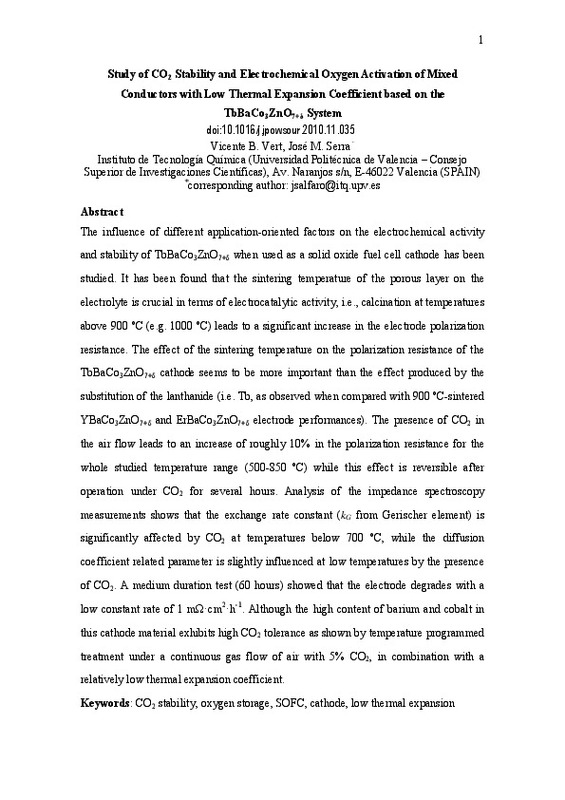JavaScript is disabled for your browser. Some features of this site may not work without it.
Buscar en RiuNet
Listar
Mi cuenta
Estadísticas
Ayuda RiuNet
Admin. UPV
Study of CO2 stability and electrochemical oxygen activation of mixed conductors with low thermal expansion coefficient based on the TbBaCo3ZnO7+δ system
Mostrar el registro sencillo del ítem
Ficheros en el ítem
| dc.contributor.author | Vert Belenguer, Vicente Bernardo
|
es_ES |
| dc.contributor.author | Serra Alfaro, José Manuel
|
es_ES |
| dc.date.accessioned | 2017-06-30T07:36:49Z | |
| dc.date.available | 2017-06-30T07:36:49Z | |
| dc.date.issued | 2011-05-01 | |
| dc.identifier.issn | 0378-7753 | |
| dc.identifier.uri | http://hdl.handle.net/10251/84195 | |
| dc.description.abstract | [EN] The influence of different application-oriented factors on the electrochemical activity and stability of TbBaCo3ZnO7+delta when used as a solid oxide fuel cell cathode has been studied. Calcination at temperatures above 900 degrees C (e.g. 1000 degrees C) leads to a significant increase in the electrode polarization resistance. The effect of the sintering temperature of the TbBaCo3ZnO7+delta cathode seems to be more important than the effect produced by the Tb substitution as observed when compared with 900 degrees C-sintered YBaCo3ZnO7+delta; and ErBaCo3ZnO7+delta electrode performances. The presence of CO2 in the air flow leads to an increase of roughly 10% in the polarization resistance for the whole studied temperature range (500-850 degrees C) while this effect is reversible. Analysis of the impedance spectroscopy measurements shows that the exchange rate constant (k(G) from Gerischer element) is significantly affected by CO2 at temperatures below 700 degrees C, while the diffusion coefficient related parameter is slightly influenced at low temperatures. Electrode degrades with a low constant rate of 1 m Omega cm(2) h(-1) after 60h. This cathode material exhibits high CO2 tolerance, as shown by temperature programmed treatment under a continuous gas flow of air with 5% CO2, and a relatively low thermal expansion coefficient. | es_ES |
| dc.description.sponsorship | Financial support by the Universitat Politecnica de Valencia (Grant UPV-2007-06), the Spanish Ministry for Science and Innovation (Project ENE2008-06302), the EU through FP7 NASA-OTM Project (NMP3-SL-2009-228701), and the Helmholtz Association of German Research Centres through the Helmholtz Alliance MEM-BRAIN (Initiative and Networking Fund) is kindly acknowledged. The revision of this paper was funded by the Politecnica de Valencia. The authors wish to thank S. Jimenez for material preparation. | en_EN |
| dc.language | Inglés | es_ES |
| dc.publisher | Elsevier | es_ES |
| dc.relation.ispartof | Journal of Power Sources | es_ES |
| dc.rights | Reconocimiento - No comercial - Sin obra derivada (by-nc-nd) | es_ES |
| dc.subject | CO2 stability | es_ES |
| dc.subject | Oxygen storage | es_ES |
| dc.subject | SOFC | es_ES |
| dc.subject | Cathode | es_ES |
| dc.subject | Low thermal expansion | es_ES |
| dc.title | Study of CO2 stability and electrochemical oxygen activation of mixed conductors with low thermal expansion coefficient based on the TbBaCo3ZnO7+δ system | es_ES |
| dc.type | Artículo | es_ES |
| dc.identifier.doi | 10.1016/j.jpowsour.2010.11.035 | |
| dc.relation.projectID | info:eu-repo/grantAgreement/EC/FP7/228701/EU/NAnostructured Surface Activated ultra-thin Oxygen Transport Membrane/ | |
| dc.relation.projectID | info:eu-repo/grantAgreement/UPV//UPV-2007-06/ | es_ES |
| dc.relation.projectID | info:eu-repo/grantAgreement/MICINN//ENE2008-06302/ES/BUSQUEDA DE NUEVOS MATERIALES CONDUCTORES DE OXIGENO E HIDROGENO EN ESTADO SOLIDO MEDIANTE QUIMICA COMBINATORIA/ | es_ES |
| dc.rights.accessRights | Abierto | |
| dc.contributor.affiliation | Universitat Politècnica de València. Instituto Universitario Mixto de Tecnología Química - Institut Universitari Mixt de Tecnologia Química | es_ES |
| dc.description.bibliographicCitation | Vert Belenguer, VB.; Serra Alfaro, JM. (2011). Study of CO2 stability and electrochemical oxygen activation of mixed conductors with low thermal expansion coefficient based on the TbBaCo3ZnO7+δ system. Journal of Power Sources. 196(9):4270-4276. https://doi.org/10.1016/j.jpowsour.2010.11.035 | es_ES |
| dc.description.accrualMethod | S | es_ES |
| dc.relation.publisherversion | http://doi.org/10.1016/j.jpowsour.2010.11.035 | es_ES |
| dc.description.upvformatpinicio | 4270 | es_ES |
| dc.description.upvformatpfin | 4276 | es_ES |
| dc.type.version | info:eu-repo/semantics/publishedVersion | es_ES |
| dc.description.volume | 196 | es_ES |
| dc.description.issue | 9 | es_ES |
| dc.relation.senia | 40417 | es_ES |
| dc.contributor.funder | Universitat Politècnica de València | |
| dc.contributor.funder | Ministerio de Ciencia e Innovación | |
| dc.contributor.funder | Helmholtz Association of German Research Centers | |
| dc.contributor.funder | European Commission |







![[Cerrado]](/themes/UPV/images/candado.png)

